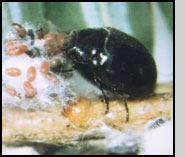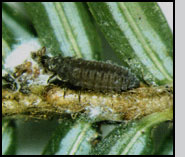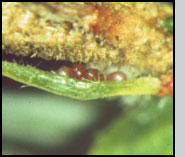 |
Back to Pathogens Table of Contents

Sasajiscymnus (formerly Pseudoscymnus) tsugae
(Coleoptera: Coccinellidae)
by Carole A. S - J. Cheah and Mark S. McClure (retired) Valley Laboratory, The Connecticut Agricultural Experiment Station, Windsor, Connecticut
Among the most widespread and effective predators of hemlock woolly adelgid (HWA), Adelges tsugae (Annand), in its native homeland of Japan is a previously non-described coccinellid. In 1992, Dr. Mark McClure collected this ladybird beetle from adelgid-infested hemlocks in 13 of 37 forests and at 11 of 37 ornamental sites in 12 prefectures throughout Honshu, Japan. Dr. Hiroyuki Sasaji and Dr. McClure described this new beetle in 1997 and named it Pseudoscymnus tsugae. In 2004, the genus was renamed Sasajiscymnus by Vandenberg as a replacement for a name already in use for a genus of shark. Henceforth, this adelgid predator is known as Sasajiscymnus tsugae.
A federal permit for the release of S. tsugae for biological control of the hemlock woolly adelgid in Connecticut was issued in April 1995. The first release of S. tsugae occurred in a town park in Windsor, Connecticut, in the spring of 1995. From 1995 to 2007, more than 176,000 adult beetles were reared and released in adelgid-infested hemlock forests throughout Connecticut. Since 1997, after the transfer of a starter colony to New Jersey, approximately 2 million beetles have been reared and released throughout the range of hemlock woolly adelgid in eastern North America from Georgia to Maine. This adelgid predatorhas now been released in 16 states, with the majority of releases occurring in the southern Appalachians in the last 8 years.

Appearance
The oval-shaped egg of S. tsugae is about 0.48 mm long by 0.25 mm wide and reddish-orange in color within an opalescent sheath or chorion. Eggs are often laid singly or in small groups in cracks and crevices in the bark and in bud scales. Larvae change from reddish-brown to gray and grow from about 1.1 mm to 2.7 mm during their four instars of development. The pupa is reddish-brown and is about 1.9 mm long and 1.1 mm wide. The newly emerged adult is light golden brown before darkening to jet black within a day. Adults are oval-shaped and are about 1.7 mm long by 1.1 mm wide. The body is entirely black and is pubescent on its dorsal surface.
In Japan, adults and larvae were found on branches of Tsuga diversifolia and T. sieboldii infested with A. tsugae throughout Honshu; adults were collected from sweep net samples of a grassy meadow in Fukui Prefecture. In the US, all life stages have been recovered from T. canadensis at release sites in Connecticut and Virginia. In Connecticut, adults could be found on infested hemlock foliage from April to November and even January during the warmest winters. Larvae were found in June and July through September in Connecticut.

Pests Attacked (Host Range)
Sasajiscymnus tsugae is only known to attack A. tsugae in nature. However, laboratory experiments revealed that S. tsugae also can feed and develop on other adelgid species, including balsam woolly adelgid, A. piceae; Cooley spruce gall adelgid, A. cooleyi; and pine bark adelgid, Pineus strobi. S. tsugae will also oviposit on balsam woolly adelgid and pine bark adelgid and can adapt to survive and reproduce on balsam woolly adelgid in the field.

Life Cycle
The life cycle of S. tsugae is well synchronized with that of its prey. Both insects have two generations each year in the field. Adult beetles overwinter, and spring egg laying by the adults normally coincides with peak egg laying and hatching of overwintering adelgids. Furthermore, a second generation of beetles occurs in June around the time that the second generation of adelgids appears. Also, when adelgids are inactive for about 14 weeks during the summer, adult ladybugs are able to survive by feeding on dormant young adelgids. Three or more generations of S. tsugae can be reared each year in the laboratory under controlled temperature conditions with the provision of developing adelgids. S. tsugae larvae and adults will feed on all stages of hemlock woolly adelgid available. S. tsugae is the only introduced predator that is bivoltine and able to survive the summer on dormant settled first instars of HWA.

Relative Effectiveness
Adults and larvae of S. tsugae are highly mobile and voraciously feed on all life stages of A. tsugae. During its development, each beetle larva consumes about 500 adelgid eggs or from 50 to 100 adelgid nymphs, depending upon the size of prey attacked. Adults can live for more than one year and may consume about 50 adelgid nymphs each week during times of peak feeding activity. Each female beetle lays nearly 300 eggs in her lifetime.
Sasajiscymnus tsugae is an important predator of A. tsugae in Japan, killing 86 to 99% of the adelgids at the 24 sites were it was studied. Experiments conducted at four sites in Connecticut and one site in Virginia from 1995 through 1997 revealed that releasing relatively few adult beetles (2,400-3,600) into an infested hemlock forest reduced adelgid densities by 47-88% on release trees in only 5 months. In the field, S. tsugae mated, reproduced, and dispersed from release trees and became established in the surrounding hemlock forest. Field recoveries in Connecticut showed that S. tsugae overwintered successfully from 1996-2005 under a wide variety of climatic conditions. Adults and larvae were recovered at 65% of Connecticut release sites one to six years after the initial release. Severe winters in the northeast in 2003, 2004, and 2009 have impacted survival of hemlock woolly adelgid, keeping Connecticut forest populations of this pest patchy and low and generally non-damaging. While S. tsugae has been difficult to recover at ground level using lower crown beat sampling, bucket truck sampling has shown that adults and larvae could be found between 5-20m in the upper canopy in Connecticut and New Jersey, indicating that adults are highly mobile and disperse upwards. Environmental conditions of cool, wet summers and cold winters have aided hemlock recovery in Connecticut. Recovery in adelgid-infested stands has been recorded statewide in Connecticut since 2005, while hemlock mortality has been minimal since 2002. More recently, in 2008 and 2009, adults and larvae of S. tsugae were recovered during lower canopy beat sampling in 22% of release sites in the Great Smoky Mountains National Park. Recoveries were made in 21% of the sites sampled, with most beetles recovered from older release sites. These studies suggest that S. tsugae releases have been successful and that the beetle has excellent potential for further biological control of A. tsugae.

Conservation
For general information about conservation of natural enemies, see Conservation in the Tutorial section on this site, or the Volume II, No. 1 Feature Article on conservation in the Midwest Biological Control News Online.

Commercial Availability
Sasajiscymnus tsugae is the only adelgid predator species available commercially and is reared on field collections of hemlock woolly adelgid. Current research is focusing on the development of artificial diets for predator mass rearing and as a supplement to aid adult survival in laboratory rearing conditions.

Supplier
Forever Green Environmental Services
P.O. Box 270
Scranton, PA 18504
570-941-9752
jaymelongohwa@gmail.com

Acknowledgments:
This research has been generously supported by the USDA Forest Service, Northeastern Area State and Private Forestry.

References
Cheah, C. 2006. Hope for hemlocks. Connecticut Woodlands 71(3):13-15.
Cheah, C.A. S-J. and M.S. McClure 1996. Exotic natural enemies of Adelges tsugae and their potential for biological control. Proc. First Hemlock Woolly Adelgid Review, USDA Forest Service, FHTET 96-10, pp. 103-112.
Cheah, C.A. S-J. and M.S. McClure 1998. Life history and development of Pseudoscymnus tsugae (Coleoptera: Coccinellidae), a new predator of the hemlock woolly adelgid, Adelges tsugae (Homoptera: Adelgidae). Environ. Entomol. 27:1531-1536.
Cheah, C.A.S-J and McClure, M.S. 2000. Seasonal synchrony of life cycles between the exotic predator, Pseudoscymnus tsugae (Coleoptera:Coccinellidae) and its prey, the hemlock woolly adelgid, Adelges tsugae (Homoptera:Adelgidae). Agricultural and Forest Entomology 2:241-251.
Cheah, C.A.S-J and McClure, M.S. 2002. Pseudoscymnus tsugae in Connecticut forests: The first five years. In: Proceedings of Hemlock Woolly Adelgid in the Eastern United States Symposium, Feb. 5-7, 2002, East Brunswick, New Jersey. Eds. Onken, B., Reardon, R. and Lashomb, J. p.150-165.
Cheah, C. and Donahue, C. 2003. Alternate adelgid prey species for Pseudocymnus tsugae establishment. Abstract; Northeast Forest Pest Council Meeting March 17-19, 2003. Online at http://cfs.nrcan.gc.ca/subsite/nefpc/abstracts/3.
Cheah, C.A.S-J., Mayer, M.A., Palmer, D., Scudder, T. & Chianese, R. 2005. Assessments of biological control of hemlock woolly adelgid with Sasajiscymnus (=Pseudoscymnus) tsugae(Coleoptera:Coccinellidae) in Connecticut and New Jersey. In the Third Symposium on Hemlock Woolly Adelgid in the Eastern United States. Asheville, NC Feb. 1-3, 2005 p. 116-130.
Cohen, A.C., Cheah, C.A. S-J, Strider, J., and Hain, F. 2008. Diet Development for Hemlock Woolly Adelgids and Their Predators. In the Fourth Symposium on Hemlock Woolly Adelgid in the Eastern United States. Hartford, CT. Feb. 12-14, 2008. p. 150-156.
Hakeem, A., Grant, J.F., Lambdin, P.L., Buckley, D., Hale, F.A., Rhea, J. R., Widggins, G. and Taylor, G. 2010. Recovery of Sasajiscymnus tsugae, released against hemlock woolly adelgid, Adelges tsugae, in the southern Appalachians. Biocontrol, Science and Technology 20(10): 1069-1074.
Hennessey, R. 1995. Field Release of a Nonindigenous Lady Beetle, Pseudoscymnus sp. (Coleoptera:Coccinellidae), for Biological Control of Hemlock Woolly Adelgid, Adelges tsugae (Homoptera: Adelgidae). Environmental Assessment. USDA-APHIS Riverdale, MD.
McClure, M.S. 1997. Biological control in native and introduced habitats: Lessons learned from the sap-feeding guilds on hemlock and pine. pp. 31-52. In D.A. Andow, D.W. Ragsdale, and R.F. Nyvall (eds.). Ecological Interactions and Biological Control. Westview Press, Boulder, Colorado.
McClure, M.S., and C. A. S-J. Cheah 1998. Released Japanese ladybugs are multiplying and killing hemlock woolly adelgids. Frontiers of Plant Science. 50(2)
Sasaji, H. and M. S. McClure. 1997. Description and distribution of Pseudoscymnus tsugae sp. nov. (Coleoptera: Coccinellidae), an important predator of hemlock woolly adelgid in Japan. Ann. Entomol. Soc. Amer. 90:563-568.
Vandenberg, N. J. 2004. Homonymy in the Coccinellidae (Coleoptera), or something fishy about Pseudoscymnus Chapin. Proceedings of The Entomological Society of Washington 106: 483-484.

Back to Pathogens Table of Contents

|
 |
Adult of S. tsugae feeding on eggs of A. tsugae.
Photo: C. Cheah
|

 |
TOP: Larva of S. tsugae feeding on eggs of
Adelges tsugae.
BOTTOM: Four eggs of S. tsugae alongside a needle of eastern hemlock.
Photos: C. Cheah
|
|
